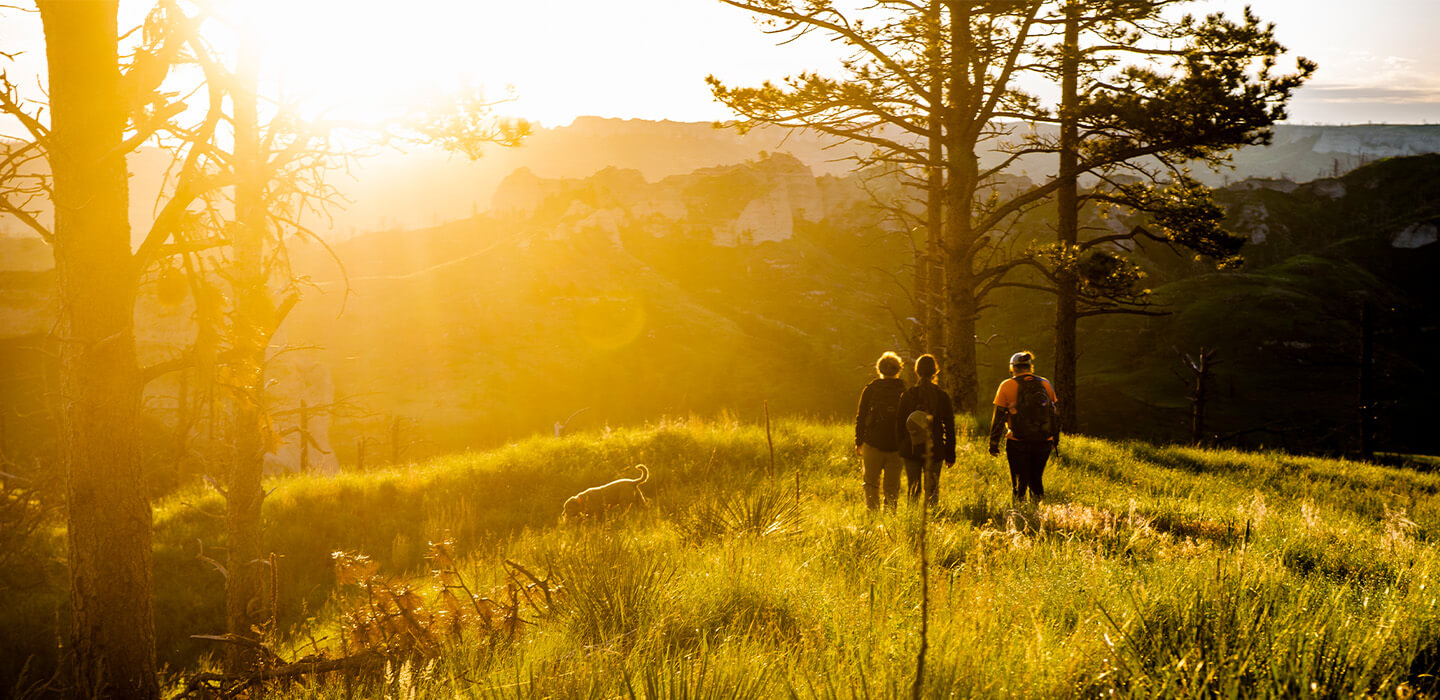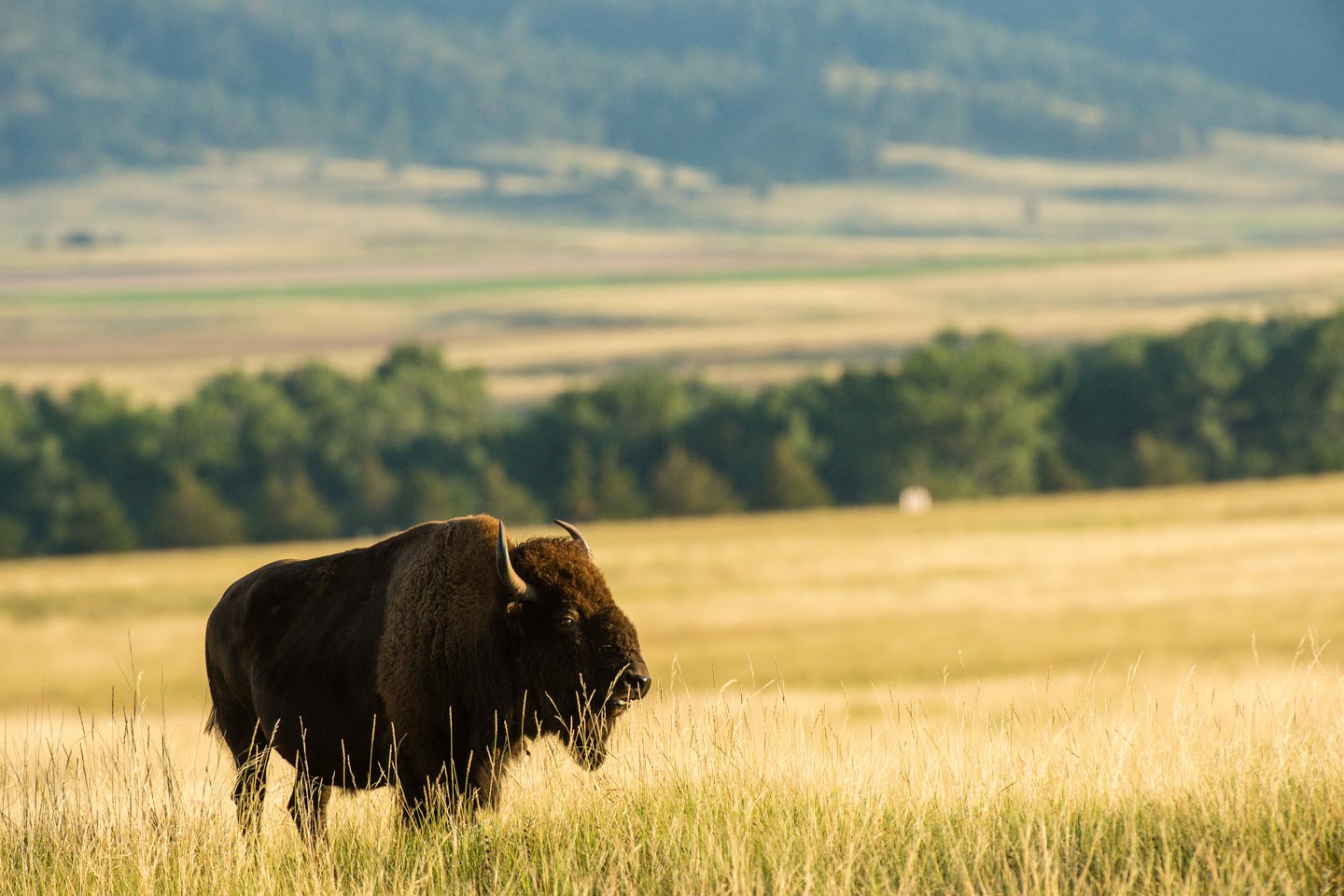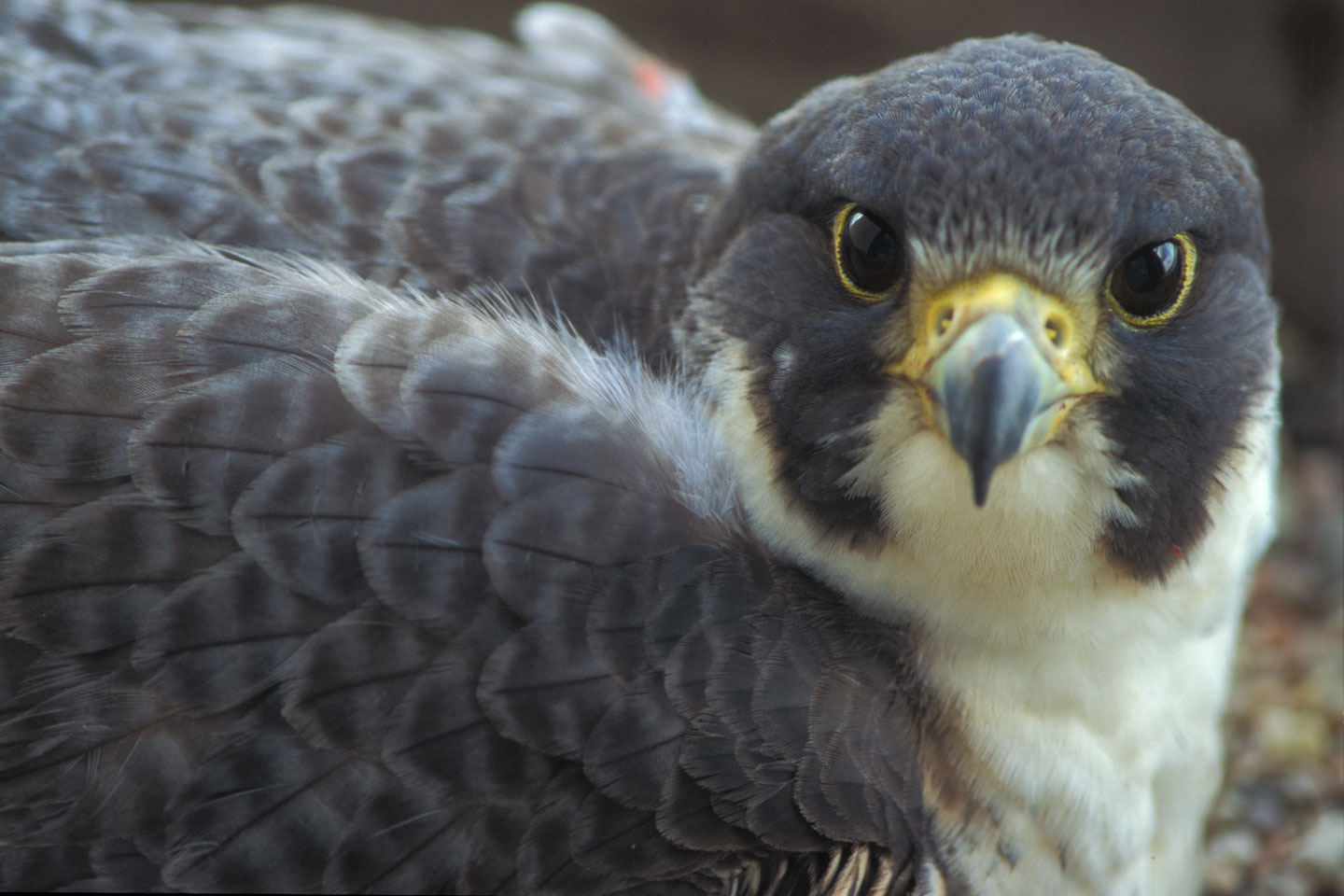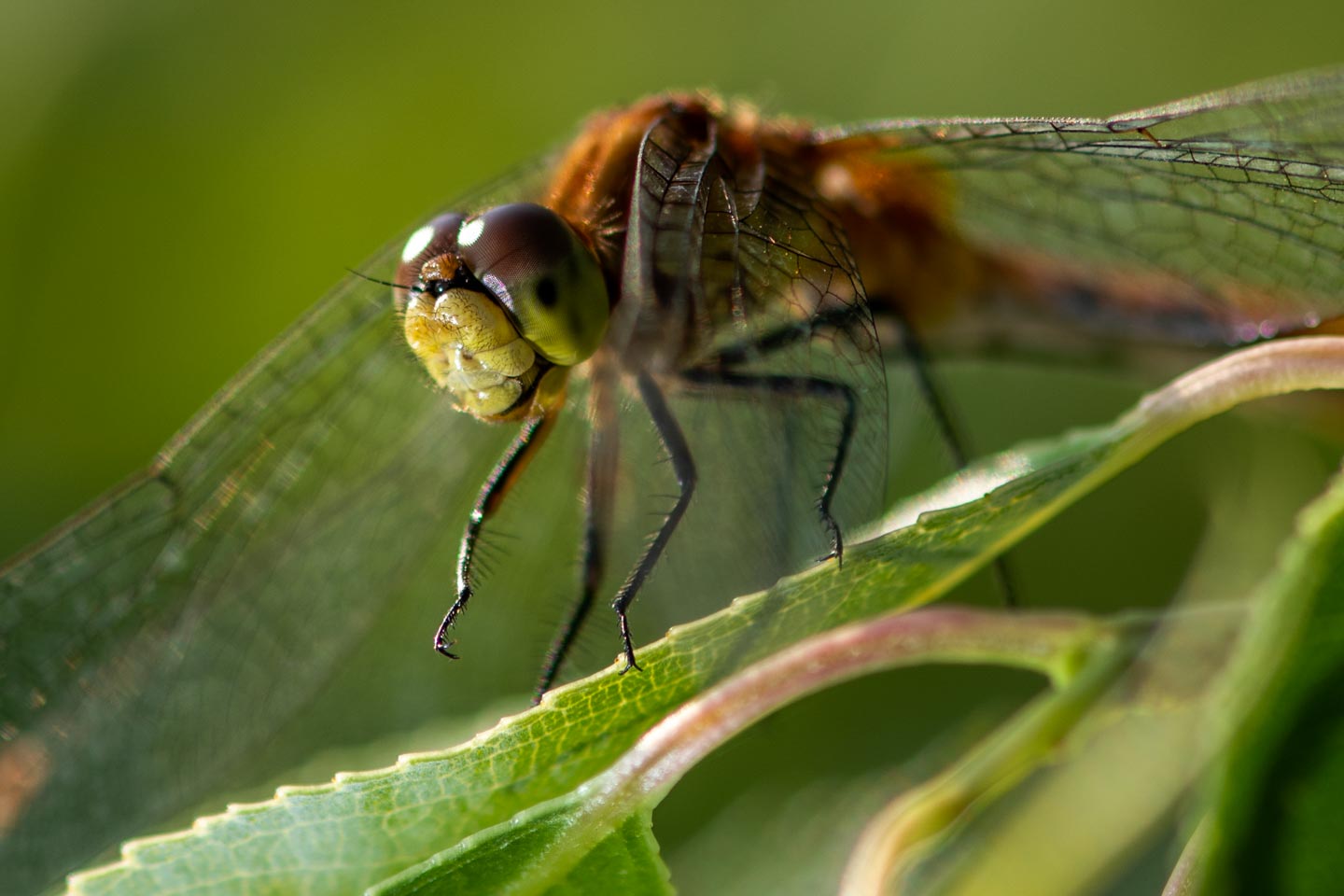Turtles
Nebraska is home to nine turtle species, each with unique characteristics, habits, habitats and food sources. Some are found statewide, others just in sections of our state. These animals are members of the reptile family tree, which also includes snakes and lizards.
Turtle species in Nebraska
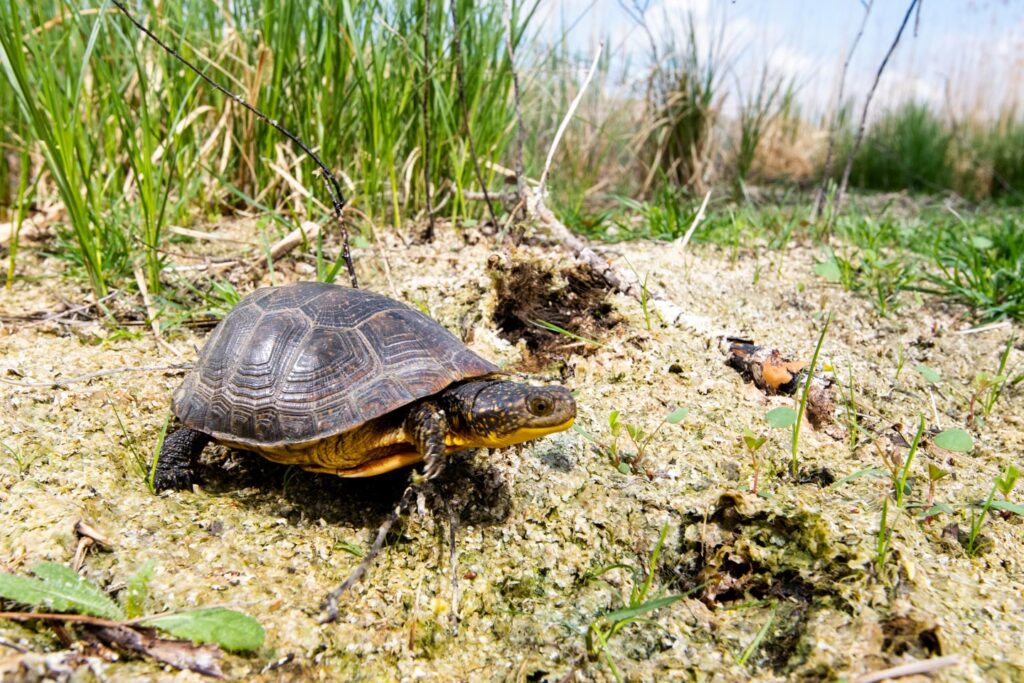
Physical description
Blanding’s turtles have a dark carapace (top part of the shell) with light yellow streaks and spots that extend to the head and neck. One of the most striking features of this turtle is the bright yellow chin and neck area. The plastron (bottom part of the shell) is yellow with black smudge marks. Their carapace is very dome-shaped, and they have a fairly long tail.
Size
Adult Blanding’s turtles are normally between 5-8 inches long. Females are larger than males.
Habitat
These turtles are mostly aquatic, however, they can travel great distances on land in the summer months. They are commonly found in marshes, permanent pools, and small streams with lots of vegetation.
Range in Nebraska
This turtle can be found in the north-central portion of the state.
Diet
The Blanding’s turtle is considered omnivorous, meaning they eat both plant material and other animals. They commonly feed on snails, earthworms, fish and frogs.
Fun Facts
>> Blanding’s turtles consume prey in both water and on land.
>> Females will nest in May through June and lay elongated, leathery-textured eggs.
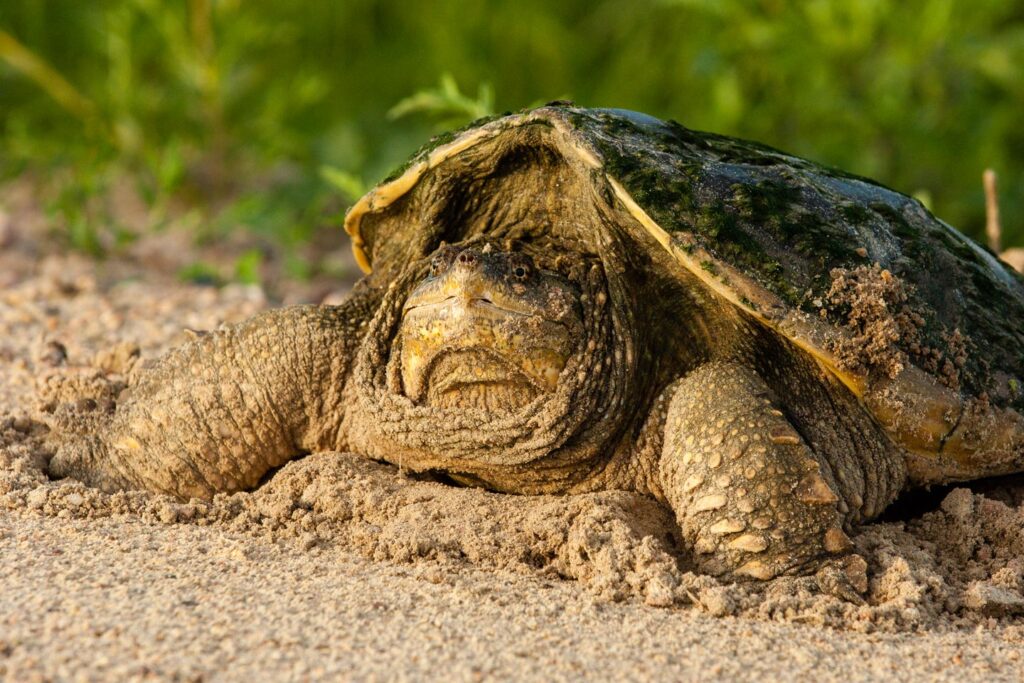
Physical description
The common snapping turtle looks like a true dinosaur. They have a large head with a long tail and an extremely reduced plastron, or bottom part of the shell. The carapace can range in colors from brown, to gray, to almost entirely black. The top part of the shell has three large “peaks” as well as a serrated texture toward the back by the tail.
Size
An adult common snapping turtle can range from 9-15 inches long and weigh up to 50 pounds or more.
Habitat
Snapping turtles can be found in almost any body of water in Nebraska, including rivers, ponds, lakes.
Range in Nebraska
Common, statewide
Diet
Common snapping turtles will eat just about anything they can find in their watery habitats, including fish, frogs, carrion (dead animals), crayfish, and aquatic plants.
Fun Facts
>> These turtles will use a “sit and wait” strategy for hunting. They will often lie still in mud or underwater and wait for their prey to pass by them. Then they will strike quickly and aggressively at anything they want to eat.
>> Females will lay eggs that are round and leathery and resemble ping-pong balls.
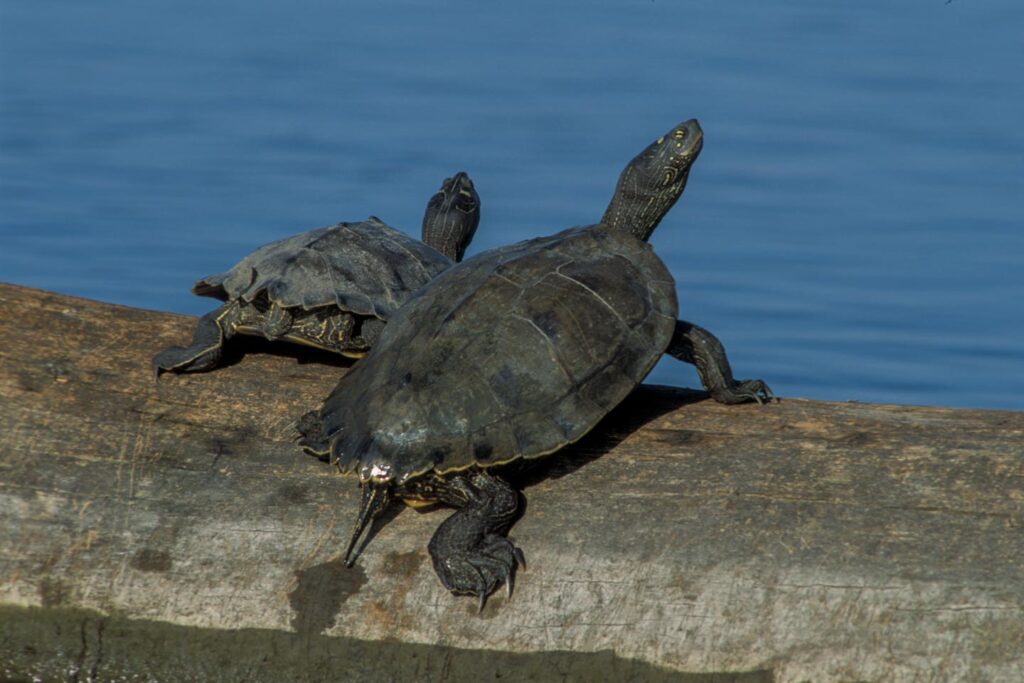
Physical description
The carapace (top part of the shell) is normally an olive green to brown color with spines running down the middle of the back. The plastron (bottom part of the shell) is creamy white or yellow. Map turtles have large paddle-like back feet to help swim within the rivers. The head and neck are heavily streaked with yellow stripes and the back part of the shell has a serrated texture.
Size
An adult false map turtle can range in size from 6-11 inches long.
Habitat
These turtles are associated with large rivers and backwater ponds. However, they also can be found in large lakes, streams, and tributaries leading to larger rivers. These turtles need basking sites, so places with fallen trees, stumps and sandy shores are preferred.
Range in Nebraska
These turtles can be found in a few counties that border the Missouri River near oxbow lakes and reservoirs.
Diet
False map turtles are omnivores, which means they consume plant material and other animals. They commonly feed on insects, insect larvae, mollusks, fish and dead fish.
Fun Facts
>> Two different species of false map turtles have been recorded in Nebraska: the false map turtle and the Mississippi map turtle.
>> Females will leave the water to find sandy soils to lay their eggs, and often lay multiple clutches throughout the year.
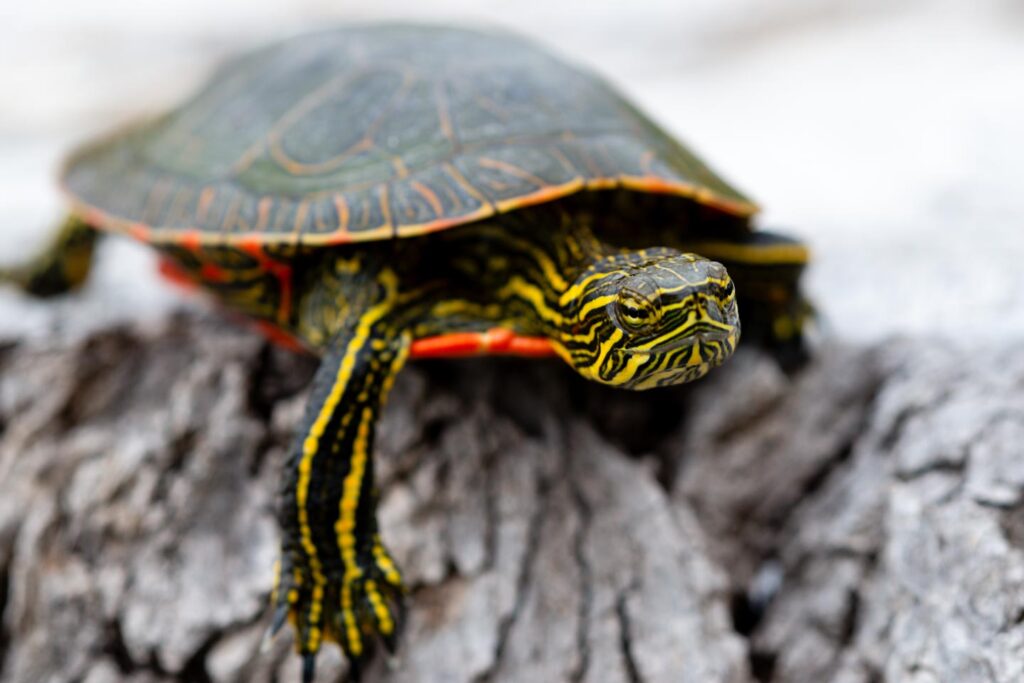
Physical description
This turtle has a very smooth carapace (top part of the shell), which is normally an olive, brown or black color. The plastron (bottom part of the shell) is where this turtle gets its name: It is patterned with red, yellow and orange blotches and lines. The head and legs of the turtle are normally a dark brown or black with yellow horizontal lines extending from the eyes down toward the neck and on the legs. Some adults will lose their color and become entirely black as they get older. Male Northern Painted turtles also will have longer claws and tails that the females.
Size
Adult Northern Painted turtles can range in size from 5-7 inches long, with females being larger than males.
Habitat
Northern Painted turtles can be found in any body of water. However, these turtles prefer permanent areas with aquatic plants like ponds and lakes. They can also be found in the Missouri, Niobrara, Platte and Republican rivers.
Range in Nebraska
This turtle can be found statewide.
Diet
These turtles are omnivores, meaning they eat plant material and other animals. Northern Painted turtles prefer to feed on items such as roots, leaves, invertebrates, fish and tadpoles.
Fun Facts
>> Northern Painted turtles are often the first turtles seen in the springtime and can be found basking on logs and rocks starting in March.
>> These turtles are considered the most commonly seen turtle in Nebraska.
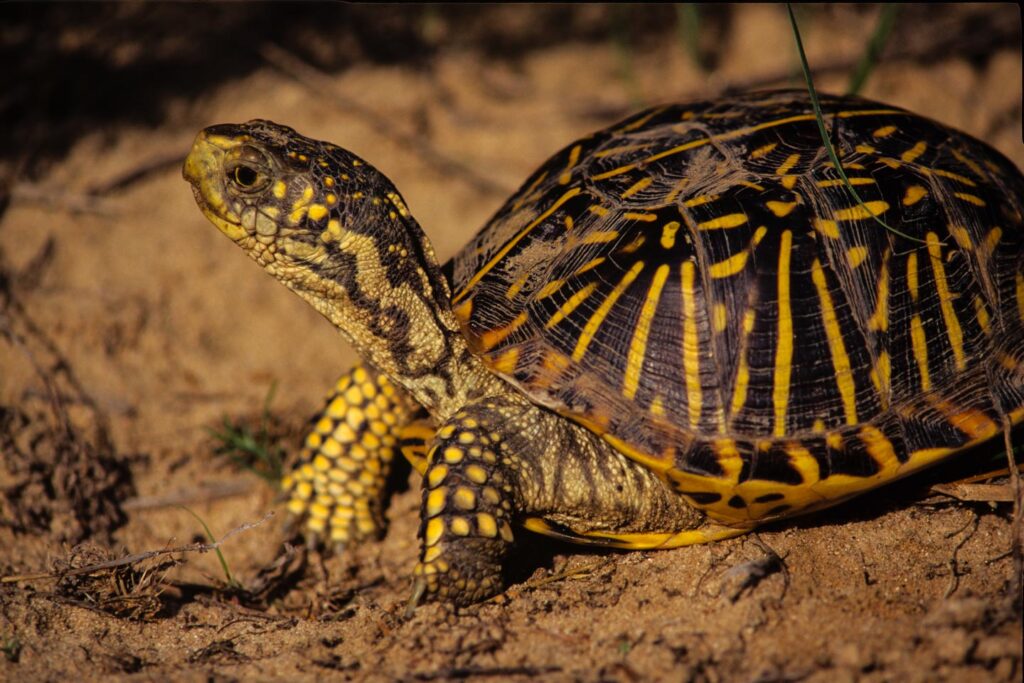
Physical description
This is Nebraska’s only native terrestrial (land) turtle. They are easily identified by the pretty pattern on their shell. On both their plastron (bottom part of shell) and carapace (top part of shell) they have a base color of brown to black with yellow lines extending from the top of the shell to the bottom of the plastron. These turtles also have yellow to orange spots on the legs, neck and head. You can distinguish males from females by their eyes. Males will have red irises while females will have maroon, yellow or green irises. Males will often have bright red markings on their front legs as well.
Size
Adult ornate box turtles rarely are larger than 6 inches in length.
Habitat
Ornate box turtles can be found in shortgrass, mixed-, and tallgrass prairies. However, they are more common in sandy or loamy soils.
Range in Nebraska
In Nebraska, they are mostly found in short and mixed-grass prairies in the western part of the state and in the sandhills.
Diet
These turtles are considered omnivorous, which means they eat both other animals and plant material. They will typically feed on succulent plants, arthropods, worms, small vertebrates, and even carrion.
Fun Facts
>> This turtle gets its name from a single hinge shell that allows them to almost completely enclose their body into the shell to escape from predators.
>> Ornate box turtles are extremely active after a rainfall.
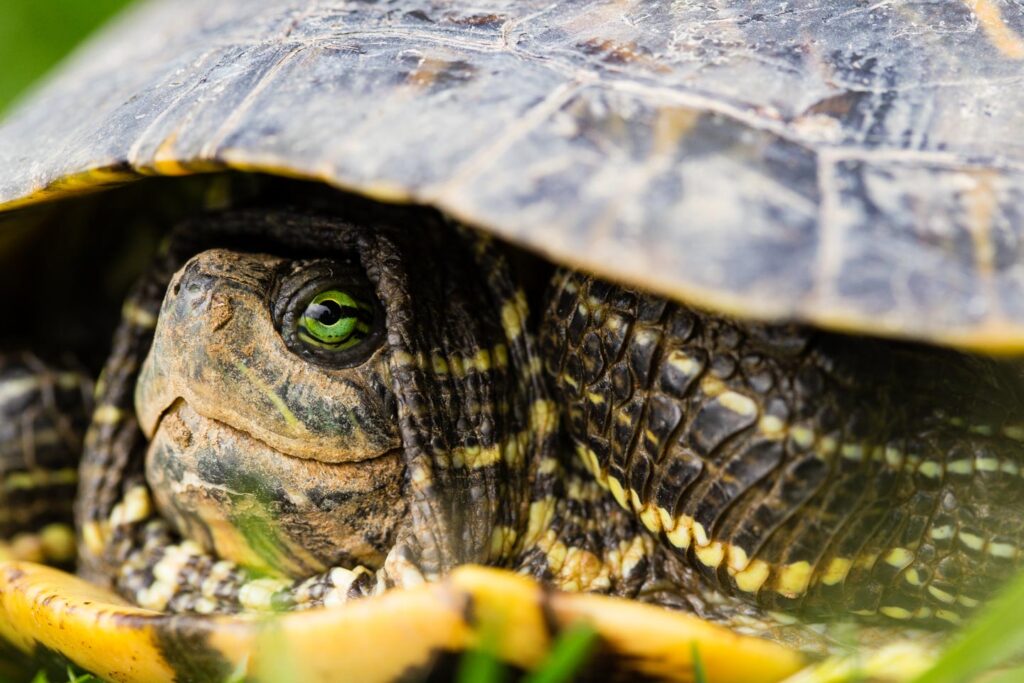
Physical description
The carapace (top of the shell) of pond sliders is normally a brown to olive-green color with occasional yellow bars. The back part of the carapace is serrated and the plastron (bottom part of the shell) is usually yellow with dark blotches on each scute, or scale. The skin color is normally green to brown with yellow stripes along the head, neck and feet.
Size
Adult sliders range in size from 7-11 inches long.
Habitat
These turtles prefer permanent ponds and marshes with lots of aquatic vegetation. Red-eared sliders can also be found in city parks, large reservoirs and canals.
Range in Nebraska
This turtle can be found naturally in Richardson County, in extreme southeast Nebraska. However, they can be found in ponds and reservoirs as released pets.
Diet
These turtles eat just about anything including: vegetation, algae, arthropods, mollusks, and even several kinds of vertebrates.
Fun Facts
>> These turtles are referred to as both “sliders” and “red-eared sliders”.
>> Sliders, like most other pond turtles, have extremely long claws which they use in mating rituals.
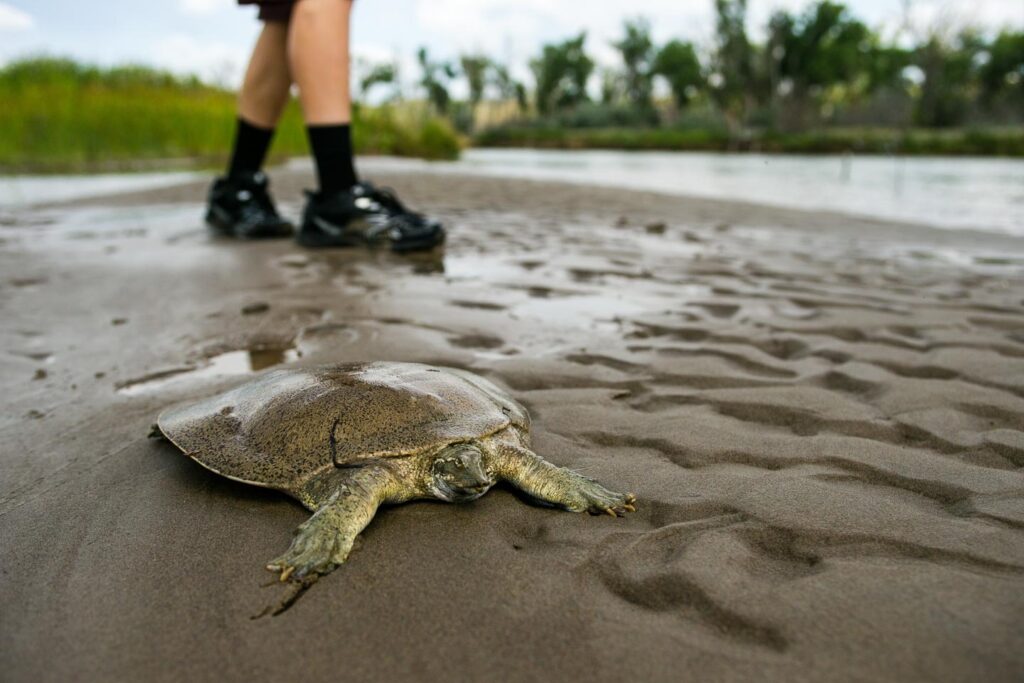
Physical description
This is one of two species of softshell turtles in Nebraska. Instead of having a hard carapace (top part of shell) this species has a soft, leathery one instead. Normally, the smooth softshell turtle is olive green to brown in color. Often times you can see part of the skeleton through the soft shell. The head, neck, and legs are often the same color as the rest of the shell. Just beneath their eye extending down to their neck is a single white stripe bordered by black.
Size
Adult smooth softshell turtles can range in length from 6.5-14 inches long.
Habitat
This is a large-river species, often preferring a sandy bottom rather than silt. These turtles can also be found in large lakes and reservoirs. Unlike other turtles, this species will often bask on a sandy beach, rather than a fallen log.
Range in Nebraska
These turtles can be found sporadically throughout the eastern part of the state. They are primarily a Missouri River species, but can also be found along the Elkhorn, Platte and Big Blue rivers.
Diet
These turtles feed on invertebrates such as insects, mollusks, and worms. However, they will often eat fish and vertebrate carrion as well. They’re rarely herbivorous (plant eaters).
Fun Facts
>> Except when it is nesting season for females, these turtles hardly ever leave the water.
>> Females will lay brittle, round eggs and then bury themselves near the nest for a short period of time.
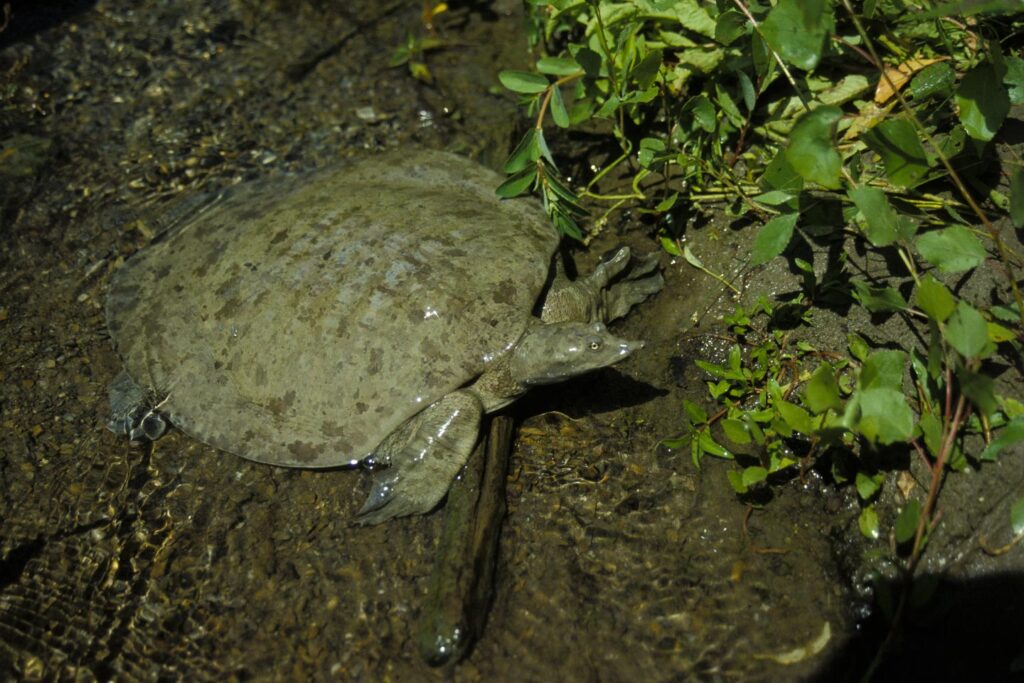
Physical description
The spiny softshell turtle is one of two softshell species in Nebraska. This species has a soft, spiny, leathery carapace (top part of the shell). They’re normally an olive green to light brown color. On the sides of their heads, a pair of yellow lines bordered by black extends from the eyes to the mouth. Male spiny softshell turtles have large, rounded dots and no dashes. Females have small dots as juveniles that develop into blotches as they become older. They also have lines and blotches on the head, neck and feet. It is often hard to tell softshell species apart, but the spiny softshell has two small projections in their nasal septum, whereas the smooth softshell does not.
Size
Adult spiny softshell turtles can range in size from 8-20 inches long.
Habitat
This turtle species is not as picky for habitat like the smooth softshell. They typically are found in streams, ponds, marshes, lakes, and reservoirs. Almost, any body of water is suitable for this turtle.
Range in Nebraska
This turtle can be found sporadically throughout the state near every major waterway.
Diet
These turtles are mostly carnivores, meat eaters, and will feed on insects, invertebrates, and will also eat dead fish or carrion (dead animals).
Fun Facts
>> Like other turtles this species will have females substantially larger than males.
>> Females will often produce two clutches of eggs each year. They are normally sphere- shaped and hard in texture.
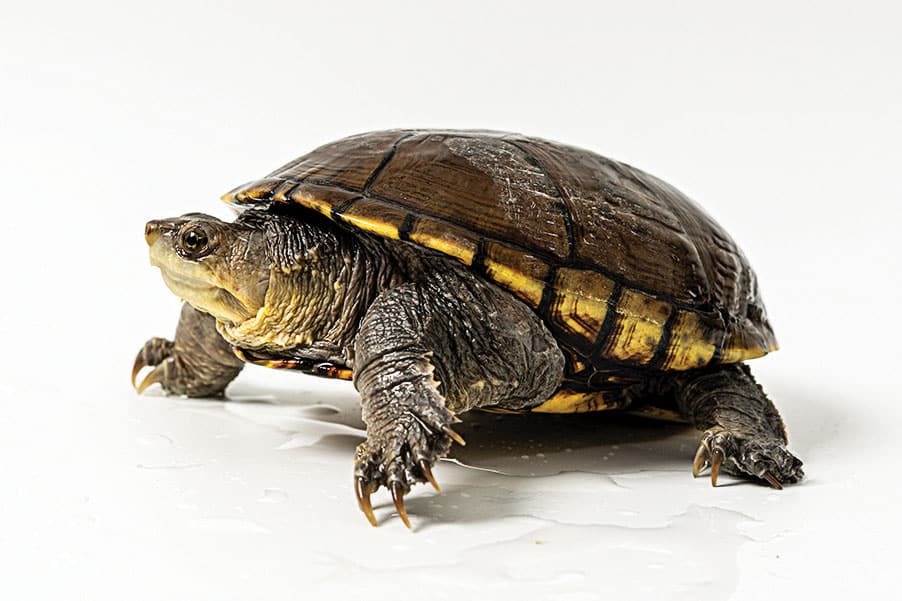
Physical description
The yellow mud turtle has a smooth and solid colored carapace (top part of shell) that is normally olive green or yellowish brown. This is the only turtle in Nebraska to have two hinges on its shell. The plastron (bottom part of shell) is usually yellow with no pattern. Its skin is gray with tubercles, or spikes, on the chin.
Size
Adult yellow mud turtles can range from 5-7 inches in length.
Habitat
This turtle can be found in nearly any permanent or temporary body of water in the short and mixed-grass prairies. They prefer areas that are muddy or sandy.
Range in Nebraska
The yellow mud turtle can be found in Sandhills wetlands and along the Republican River in the southwestern part of the state.
Diet
Unlike other turtles, these animals are mostly carnivorous, meaning they will eat only meat. They commonly feed on snails, crustaceans and earthworms.
Fun Facts
>> The main predator of yellow mud turtle eggs and hatchlings is the western hognose snake.
>> This is the only species of turtle in the world to nest while completely underground.
Curious for more?
Explore our pages dedicated to the reptiles, snakes and lizards, too.

